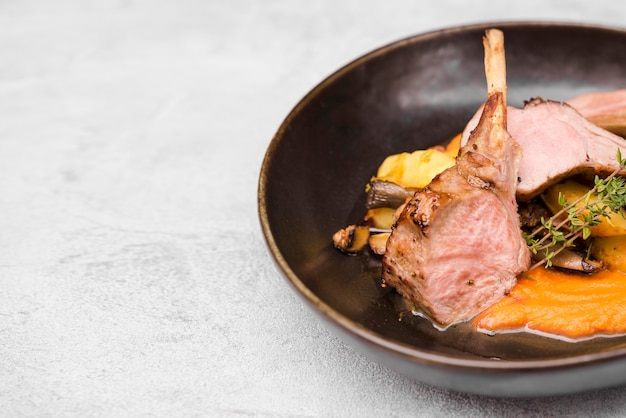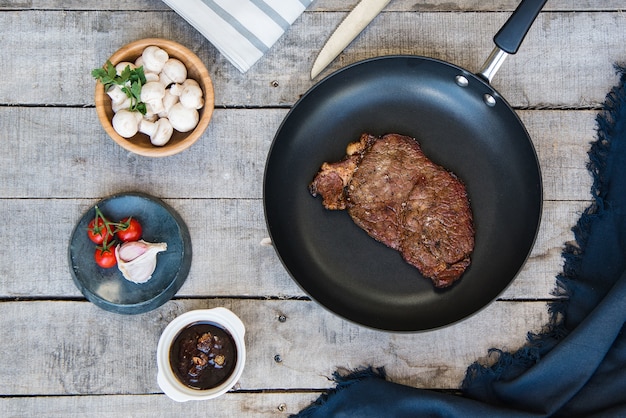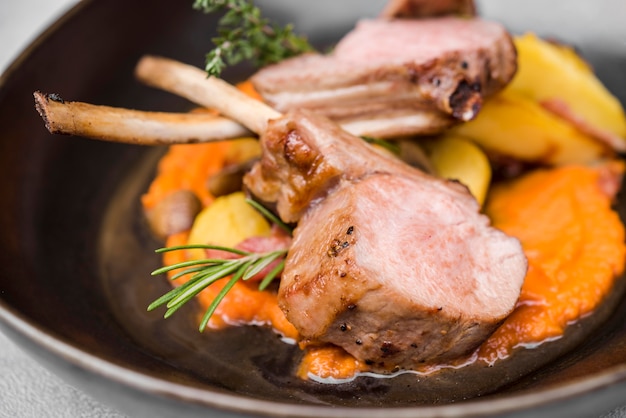Let's talk filet mignon. It's not just any steak, it's a culinary masterpiece. A symbol of indulgence, and frankly, a bit of a challenge to get just right. But fear not, fellow meat lovers, because I'm here to guide you through the journey of mastering this luxurious cut. Filet mignon has been my culinary companion for years, and I've seen it both rise and fall, cooked to perfection and sadly overdone. But through it all, I’ve learned a thing or two about how to get it spot on. Let me share my secrets, my triumphs, and even a few of my culinary blunders (because even the best of us make mistakes, right?).
(Part 1) The Allure of Filet Mignon

The Cut: The Crown Jewel of Beef
First things first, let's talk about the cut itself. Filet mignon is the most tender part of the beef tenderloin, a long, cylindrical muscle that runs along the backbone of the cow. Think of it like the prime real estate of the cow, and you'll understand why it's considered a luxury cut. It’s basically the muscle that doesn’t get much use, making it incredibly soft and flavorful. The filet mignon, often referred to as the "chateaubriand," is the thickest part of the tenderloin and is revered for its melt-in-your-mouth texture and exquisite flavor.
The Flavor: A Symphony of Subtlety
Now, here’s the thing about filet mignon: it’s not your typical steak. It won't have a strong, robust flavor like a ribeye or a new york strip. Filet mignon is all about delicacy. It has a subtle, almost sweet flavor, with a hint of gaminess that just makes it irresistible. Think of it like a whisper in your ear, rather than a shout. This refined flavor profile calls for a mindful approach to cooking and careful consideration of accompanying sauces and side dishes.
The Versatility: A Culinary Canvas
Filet mignon is a blank canvas for your culinary creativity. You can grill it, pan-sear it, bake it, roast it, you name it. It takes to just about any cooking method you throw at it. And let's not forget the sauces! From classic béarnaise to creamy mushroom sauce, the possibilities are endless. The key is to choose a sauce that complements the subtle flavor of the steak, rather than overpowering it. Don’t be afraid to get creative!
(Part 2) Choosing the perfect filet mignon

Grade Matters: Picking a Winner
Now that you're ready to embark on your filet mignon journey, let's talk about choosing the perfect piece. The first thing you need to do is get yourself a quality cut. Look for a steak that’s graded "Choice" or "Prime." Those are the top two grades, and they'll ensure a tender and flavorful steak. Now, I personally prefer Prime, but honestly, both are delicious. It's all about what your budget and your personal preference are.
Marbling: The Secret to Flavor
Next, look for marbling. Marbling is the little streaks of fat throughout the meat. It's like the secret ingredient that gives filet mignon its rich, juicy flavor. The more marbling, the more flavorful your steak will be. So, if you see a steak with beautiful, evenly distributed marbling, go for it.
Thickness: Getting it Right
Thickness is also important, especially if you're going for a perfectly cooked steak. You want a steak that's about 1-1.5 inches thick. It's thick enough to cook evenly and maintain its juiciness, but not so thick that it takes forever to cook. And, just as an extra tip, I always like to get my steak at least a day before I cook it. I store it in the fridge, and let it come to room temperature before cooking. This helps ensure a more even cook and prevents the steak from being shocked by the sudden temperature change.
(Part 3) Mastering the Cooking Technique

Seasoning: A Simple Touch
Now, you've got your perfect filet mignon. Time for the fun part: seasoning! Don't overcomplicate it. The beauty of filet mignon is that it doesn't need a lot of fuss. I keep it simple and use good quality kosher salt and freshly ground black pepper. A little bit of garlic powder or onion powder can be a nice touch too.
Pre-Heating: Getting Ready
Next, preheat your pan or grill. I always use a cast-iron skillet for pan-searing, but a good quality non-stick pan works just as well. Get that pan screaming hot. You want it hot enough to create a beautiful sear on the outside of the steak, while keeping the inside perfectly tender and juicy.
Sear, Flip, and Repeat
Ok, here’s where the real magic happens. Place your steak in the hot pan, and don't move it! Let it cook for about 2-3 minutes per side. This creates that lovely crispy crust on the outside. Then flip it over and cook for another 2-3 minutes. You want to get a nice, even brown crust on both sides. After that, reduce the heat and cook to your desired doneness.
(Part 4) Reaching the Desired Doneness
Now, the doneness of your filet mignon is a matter of personal preference. The key is to understand the different levels of doneness and how they affect the texture and flavor of the steak. Here's a breakdown of the most common doneness levels, along with what to look for and feel for:
Rare: A Touch of Red
A rare steak is cooked only briefly, leaving the center cool and slightly red. It should be a little bit springy to the touch, almost like a raw egg white. It's important to note that consuming rare meat carries a higher risk of foodborne illness, so ensure you're sourcing your meat from a reputable butcher and are comfortable with the risks involved.
Medium-Rare: The Classic Choice
For a medium-rare steak, the center should be warm and slightly pink. It should feel firm to the touch, and have a little bit of give. This is the classic doneness for filet mignon, as it balances the tenderness of the meat with a hint of pink and a warm center.
Medium: The Safe Zone
A medium steak is cooked through, but still has a bit of pink in the center. It should be warm and firm to the touch, and have a slight springy feel. This level of doneness is a good choice for those who want a more cooked steak but still want to maintain some of the tenderness and flavor of filet mignon.
Medium-Well: A Little More Done
If you prefer your steak medium-well, the center should be mostly cooked through, with just a hint of pink. It should be warm and firm to the touch, with little to no give. Medium-well is a safe choice for those who are unsure about their preferred doneness, or who are more cautious about consuming undercooked meat.
Well-Done: All the Way Through
And finally, a well-done steak is fully cooked through. The center should be brown throughout, and feel firm to the touch. This is a good option if you're cooking for someone who prefers their steak well done, or if you're unsure about the doneness of the steak. However, be warned, cooking a filet mignon well-done can result in a drier and less flavorful steak.
(Part 5) Using a meat thermometer
Now, I know what you're thinking: "How do I know if my steak is cooked to the right doneness?" Well, I've got you covered. The best way to ensure a perfect filet mignon is to use a meat thermometer. It's the ultimate cheat sheet for cooking a steak to your exact preference.
Temperature Chart
Here's a handy temperature chart to guide you:
| Doneness | internal temperature (°F) |
|---|---|
| Rare | 125-130 |
| Medium-Rare | 130-135 |
| Medium | 140-145 |
| Medium-Well | 150-155 |
| Well-Done | 160 |
Insert the thermometer into the thickest part of the steak, making sure it doesn't touch any bone. Let it sit for a few seconds, and then check the reading. You'll know exactly when your steak is cooked to perfection!
(Part 6) Resting: A Crucial Step
Ok, so you've cooked your filet mignon to perfection. But wait! Don't cut into it just yet. Let your steak rest for at least 5-10 minutes before slicing and serving.
Why Resting is Essential
Resting is crucial for a few reasons. Firstly, it allows the juices to redistribute throughout the steak. This makes your filet mignon incredibly juicy and tender. Secondly, it lets the steak relax. You see, when you cook a steak, the muscle fibers contract, which can make the meat tough. Resting allows the muscle fibers to relax, resulting in a more tender and flavorful steak.
(Part 7) Slicing and Serving: The Grand Finale
Now, here's the moment of truth. After resting, it's time to slice and serve your masterpiece. I always use a sharp knife to cut the steak against the grain. This makes the steak easier to chew and gives it a beautiful texture.
Choosing the Right Plate
A simple and elegant plate complements the filet mignon. I prefer to keep things classic with a white plate, but you can use whatever you like. You can add a touch of color with a simple garnish of fresh herbs or a sprig of rosemary.
The Ultimate Presentation
To elevate the presentation, try a simple technique. I always like to drizzle a little bit of sauce on the plate, and then place the steak on top. It’s a simple touch that really elevates the overall look of the dish. You can also create a visual contrast by adding a small mound of mashed potatoes or a scattering of roasted vegetables.
(Part 8) Side Dishes: Complementing the Star
Filet mignon is a star, but it needs a supporting cast of side dishes to complete the culinary experience. A classic side dish is mashed potatoes, and they make an incredibly satisfying companion to the richness of the steak.
Classic Combinations
- Mashed Potatoes: The creamy comfort of mashed potatoes is a perfect match for the luxurious filet mignon. You can elevate this classic pairing by adding herbs, cheese, or a touch of butter.
- Roasted Vegetables: A medley of roasted vegetables like asparagus, Brussels sprouts, or carrots adds vibrant color and a touch of earthy flavor. The roasting process caramelizes the natural sugars in the vegetables, creating a delightful sweetness that contrasts well with the savory steak.
- Mushroom Risotto: A creamy and flavorful risotto is a sophisticated choice that complements the delicate flavor of the steak. The creamy texture of the risotto contrasts beautifully with the tender steak, while the earthy flavors of the mushrooms add depth to the overall experience.
Don't Be Afraid to Experiment
Remember, filet mignon is incredibly versatile. Don't be afraid to experiment with different side dishes to find your perfect combination. A simple green salad is always a refreshing option, and a light and tangy sauce can add a touch of brightness to the plate. You can also consider seasonal fruits like grilled peaches or figs, or a light and airy potato gratin.
(Part 9) The Art of Sauces: Elevating the Flavor
Now, let's talk about the finishing touch: the sauce. A good sauce can elevate a filet mignon to a whole new level, complementing its subtle flavor and adding an extra layer of richness and complexity.
Classic Choices
- Béarnaise Sauce: This classic French sauce, made with egg yolks, butter, and tarragon, is rich, creamy, and subtly tangy. It's a perfect match for the delicate flavor of filet mignon. The tanginess of the sauce cuts through the richness of the steak, creating a balanced and satisfying flavor profile.
- Mushroom Sauce: A simple, earthy mushroom sauce made with sautéed mushrooms, garlic, and wine is another delicious option. The earthy flavor of the mushrooms complements the delicate flavor of the steak, and the addition of wine adds a touch of complexity.
- Peppercorn Sauce: For those who love a bit of spice, a peppercorn sauce adds a punch of flavor and a touch of heat. The peppery notes of the sauce provide a welcome contrast to the subtle sweetness of the filet mignon.
A Twist on Tradition
If you're feeling adventurous, there are plenty of other sauces you can explore. I love a simple red wine reduction sauce, or a creamy garlic sauce. The key is to choose a sauce that complements the flavor of the steak and adds a touch of something special. You can also experiment with citrus sauces, like a lemon-herb sauce, or a bold chimichurri sauce.
(Part 10) Enjoying Your Culinary Creation
Right, you've gone through the whole process. Now you've got a perfectly cooked, beautifully presented filet mignon in front of you. So, take a moment to appreciate your culinary masterpiece! It's a testament to your skill and dedication.
The Art of the Bite
Take a bite. Let the tender steak melt in your mouth. Taste the subtle flavor of the meat, enhanced by the delicious sauce and the delicate touch of your chosen side dishes. Close your eyes and savor the moment. It’s a moment of pure indulgence.
Sharing the Experience
Now, if you're sharing this experience with others, make sure to give them a slice of your culinary creation. Watch their faces as they take their first bite. See the delight in their eyes as they experience the perfect filet mignon. And remember, this is more than just a meal; it’s a moment of pure satisfaction.
FAQs
Q1. What is the best way to cook filet mignon?
That really depends on your preference. I love pan-searing, as it creates a beautiful crust and allows for precise temperature control. However, grilling, baking, or roasting can also yield delicious results. Just make sure you cook it to your desired doneness.
Q2. How long should I cook filet mignon?
The cooking time will vary depending on the thickness of the steak and your preferred doneness. For a 1-inch thick steak, I usually cook it for 2-3 minutes per side for a medium-rare finish. Always use a meat thermometer to check the internal temperature.
Q3. What are some good side dishes for filet mignon?
Classic side dishes like mashed potatoes, roasted vegetables, or a mushroom risotto are all delicious choices. You can also opt for a simple green salad or a light and tangy sauce. Don't be afraid to get creative and try seasonal fruits like grilled peaches or figs, or a light and airy potato gratin.
Q4. What is the best sauce for filet mignon?
That's a matter of taste! Some popular choices include béarnaise, mushroom sauce, and peppercorn sauce. You can also try a red wine reduction, a creamy garlic sauce, or experiment with citrus sauces, like a lemon-herb sauce, or a bold chimichurri sauce. Experiment and find your favorite!
Q5. How do I know when filet mignon is cooked to the right doneness?
The best way to ensure a perfect filet mignon is to use a meat thermometer. Check the internal temperature to make sure it's cooked to your exact preference. For those who prefer to rely on touch, a rare steak will be cool and slightly red in the center, a medium-rare steak will be warm and slightly pink, and a medium steak will be cooked through but still have a bit of pink in the center.
Everyone is watching

How to Cook Frozen Lobster Tails Perfectly: A Step-by-Step Guide
RecipesLobster. Just the word conjures up images of lavish meals, special occasions, and a taste of luxury. But let's...

Pigs in a Blanket Cooking Time: How Long to Bake for Perfect Results
RecipesAh, pigs in a blanket. Just the name conjures up images of those delightful little parcels of crispy pastry en...

Pork Fillet Cooking Time: How Long to Cook It Perfectly
RecipesPork fillet, or tenderloin as it's sometimes called, is a real favourite in our house. It's so versatile, and...

The Ultimate Guide to Cooking Delicious Frankfurters
RecipesLet's face it, we all love a good frankfurter. It's a classic, simple, and always satisfying. But let's be rea...

Wolf Meat Recipes: A Guide to Cooking Wild Game
RecipesLet's be honest, you don't see wolf meat at your local butcher shop every day. It's a bit of a wild card, but ...
